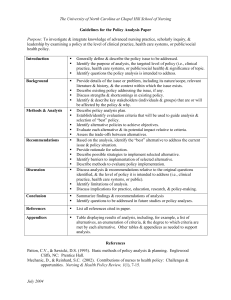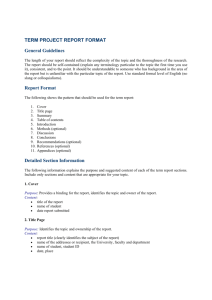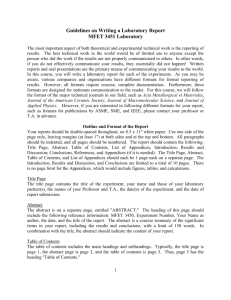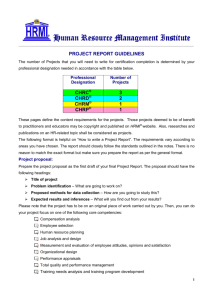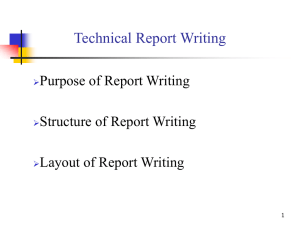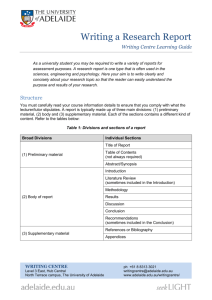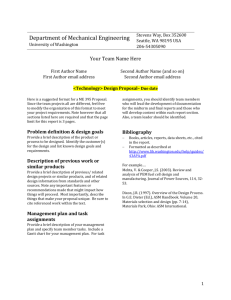Technical Report Writing
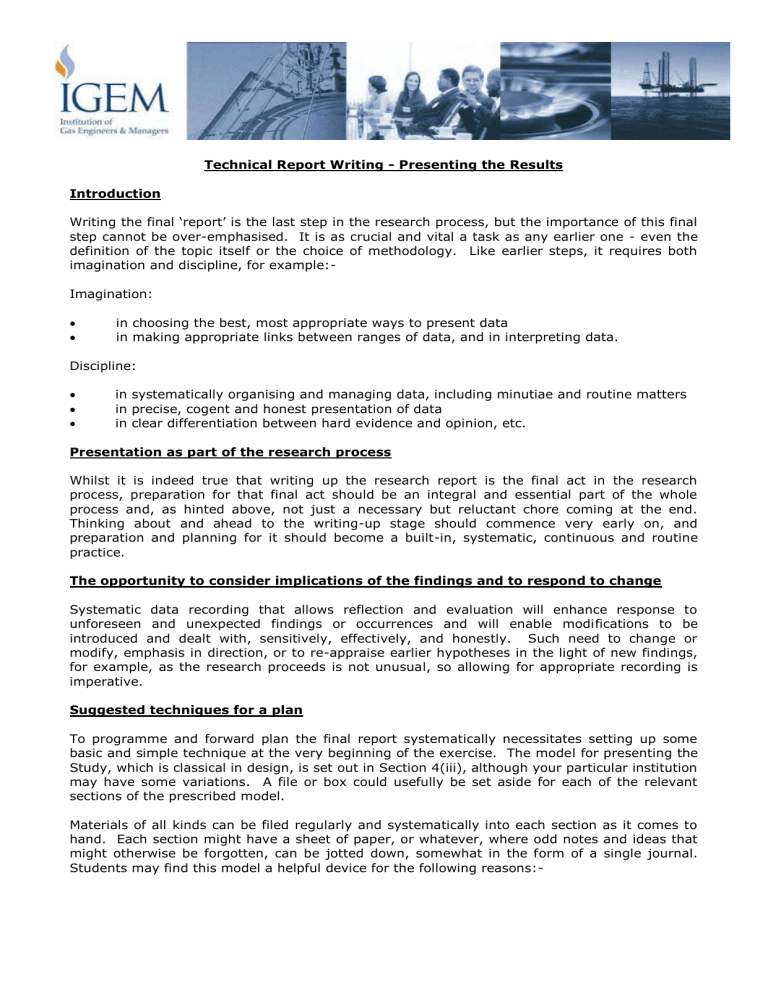
Technical Report Writing - Presenting the Results
Introduction
Writing the final ‘report’ is the last step in the research process, but the importance of this final step cannot be over-emphasised. It is as crucial and vital a task as any earlier one - even the definition of the topic itself or the choice of methodology. Like earlier steps, it requires both imagination and discipline, for example:-
Imagination:
in choosing the best, most appropriate ways to present data in making appropriate links between ranges of data, and in interpreting data.
Discipline:
in systematically organising and managing data, including minutiae and routine matters in precise, cogent and honest presentation of data in clear differentiation between hard evidence and opinion, etc.
Presentation as part of the research process
Whilst it is indeed true that writing up the research report is the final act in the research process, preparation for that final act should be an integral and essential part of the whole process and, as hinted above, not just a necessary but reluctant chore coming at the end.
Thinking about and ahead to the writing-up stage should commence very early on, and preparation and planning for it should become a built-in, systematic, continuous and routine practice.
The opportunity to consider implications of the findings and to respond to change
Systematic data recording that allows reflection and evaluation will enhance response to unforeseen and unexpected findings or occurrences and will enable modifications to be introduced and dealt with, sensitively, effectively, and honestly. Such need to change or modify, emphasis in direction, or to re-appraise earlier hypotheses in the light of new findings, for example, as the research proceeds is not unusual, so allowing for appropriate recording is imperative.
Suggested techniques for a plan
To programme and forward plan the final report systematically necessitates setting up some basic and simple technique at the very beginning of the exercise. The model for presenting the
Study, which is classical in design, is set out in Section 4(iii), although your particular institution may have some variations. A file or box could usefully be set aside for each of the relevant sections of the prescribed model.
Materials of all kinds can be filed regularly and systematically into each section as it comes to hand. Each section might have a sheet of paper, or whatever, where odd notes and ideas that might otherwise be forgotten, can be jotted down, somewhat in the form of a single journal.
Students may find this model a helpful device for the following reasons:-
It allows all sections to be worked on concurrently and the report to be gradually compiled, allowing for change and modification all the time
It simplifies the organisation and management of what might be a substantial amount of varied material
It ensures that data is collated and processed as logically and cogently as possible
It allows trial and error in the choice of the most appropriate way of presenting data - e.g. it allows time to make decisions about:-
(a) whether data will be presented in verbal form, or by diagrams or graphs etc., or by a variety of different combinations
(b) which data will be integrated into the body of the report, and which put in appendices etc?
(c) a much more painful decision, what data will be left out?
It enables the best balance between sections and the whole to be achieved - e.g. it helps to make sure that a résumé of findings, or conclusions and recommendations, are what they say and not detailed findings repeated
It ensures maximum use is made of discussion times with tutors thus furthering processes of reflection, revision, evaluation and modification
It helps build confidence as one can see the jig-saw falling into place and more and more of the pieces being put together - e.g. Section (1) Reason for the Study and Statement of Topic (or problem) should be completed before embarking on the field study - (apart from tidying up) and very early on give one the feeling of something substantial already achieved, upon which one gradually builds.
Style
Reporting successfully on the research study is a matter of good communication. The purpose of a report is not communication with oneself, but communication with the audience ...... a perusal of social research documents will show that all too many bear the stamp of a struggle for clarification of the author’s own thoughts (and are) ‘not designed to communicate with an audience about problems it would find difficult’. The process of clarification, of determining what you need to communicate should take place before writing-up. Writing-up the report should be a matter of determining how best to communicate, allowing thought to be given to style. Five cardinal principles underpin clarity of style and presentation, namely:-
1)
2)
Accuracy
Clarity
3)
4)
5)
Simplicity
Logical development
A pleasing physical appearance of the report as a whole.
2
These five overlap and are inter-related, but for easier presentation they are dealt with separately here.
1) Accuracy
The object of writing an account of research is to convey information with (i) precision and (ii)
with honesty, Lloyd (2001).
1 This requires discipline in the following areas:- clear differentiation between fact, opinion and interpretation the substantiation of fact by relevant evidence wherever possible absolute certainty those facts are correct - i.e. check that mistakes are not made in typing/writing etc., it is surprising how easily mistakes of this kind are made.
Sometimes authors fail to meet these fundamental criteria of accuracy: frequently statements of a general nature are made as if they were fact, and sometimes they cannot be supported by factual evidence on further investigation. This is not permissible behaviour in advanced research studies.
2) Clarity
It is important to achieve clarity of:-
Language
The totality of the presentation.
Mann (1976) talks of this clarity in putting the whole together and suggests the desirability of a
‘flow’ which comes from one section leading naturally into the next.
2 If the research is properly thought out and planned, the naturalness will be there but if it has been badly planned and not adequately thought out in advance, then the natural flow will be replaced by a jerky progression which will show where the parts fail to fit together properly. Research which is good to read, clearly presented and satisfying in its results, does not just happen out of the blue - the ‘ten per cent inspiration must be built around and supported by the ninety per cent perspiration’,
Einstein and Infield (1938).
3 This underlines the earlier point that preparation of the final report should commence early. The necessary skills come relatively easily to some people perhaps, but most of us lesser mortals have to work hard at it!
3) Simplicity
By simplicity we should not mean dullness, but rather a refined, straight- forwardness. Three statements, which epitomise this idea of ‘simplicity’, are given below:-
‘Most of the fundamental ideas of science are essentially simple and may, as a rule, be expressed in a language comprehensive to everyone’, Einstein and Infield (1938).
4
‘Even for the Physicist the description in plain language will be a criterion of the degree of understanding that has been reached’, Heisenberg (1958).
5
1 Lloyd, G. C. (2001) ‘A Guide to Report Writing’, Rajarata University, Mihintale, Sri Lanka.
2 Mann, P. H. (1976) ‘Methods of Sociological Enquiry’, Blackwell, London.
3 Einstein, A. and Infield, L. (1938) ‘The Evolution of Physics: The growth of ideas from early concepts to relativity and quanta, Simon and Schuster, New York.
4 Op. cit.
5 Heisenberg, W. (1958) ‘Physics and Philosophy - The Revolution in Modern Science’, Harper & Row, New York.
3
‘If you cannot - in the long run - tell someone what you have been doing, your doing has been worthless’, Schrodinger (1951).
6
Accuracy, clarity and simplicity require correct grammatical structure and spelling. Spelling and grammar checking software is built into computer programs so it should be used frequently. It is also an essential discipline to SAVE your work frequently on both hard disc and back-up discs/memory stick.
There is a need to control the use of ‘jargon’ or technical terms, although it is, of course, permissible, even essential, to use some technical terms and concepts in a complex report.
Their meaning should be clear and if necessary a definition given and they should only be used when absolutely necessary for clarity and precision or meaning in the text. It is pretentious and unnecessary to over - use technical terms and this does little to impress the reader.
It is also important to explain to the reader of your completed work the meanings of any abbreviations used throughout the text, for example NATO. You should give the full name as a prefix followed by the abbreviation in brackets e.g. North Atlantic Treaty Organisation (NATO).
Once this has been done there is no further need to refer to the name in full, NATO will suffice.
4) Logical Development
The need for logical development of the final report has already been touched upon in regard to ideas to do with achieving a ‘flow’ of argument and ideas through the report and of linking the parts to each other and to the whole logically and clearly. One should try to avoid fragmentation, 'bittiness' and disjointedness.
5) Pleasing Physical Appearance and Attractiveness of the Research Report as a
Whole
A well laid-out, well put together package that is clear, tidy and attractive will attract and will project the image of a task well done and of a project ably executed. Occasionally the package may look good but the contents may be inferior, but hopefully this is likely to be an exception to the rule.
The final presentation of the report is an important matter of communication: it is a matter of selling or marketing the product: one aims to ensure that the reader is stimulated to want to
read the document. One of the best compliments to receive from a research supervisor is that your final report ‘was a good read’. Attention to detail is essential, for example:- a title page and a clear table of contents giving page numbers is essential page numbering throughout must be precise and methodical
layout throughout should be clear and tidy.
Regulations governing the presentation of theses will be found in the appropriate university student guidelines for submission. Check these guidelines carefully as different institutions may require a different format and some are more specific than others. These guidelines will include font size, type, margins, use of footnotes as well as chapter layout plus other essential information.
6 Schrodinger, E. (1951) ‘Science and Humanism’, Cambridge University Press.
4
Model for the Research Report
In the production of the final publication the following layout could be considered the classical model, however different courses and institutions will have a different format for layout which
3)
4)
5)
6)
7) may (or may not) include all of the following:-
1)
2)
Title Page
Declaration
Abstract
Acknowledgements
Contents Page
List of Tables
Introduction, Aims and Objectives of Research
8)
9)
Literature Review
Research Methodology
10) Main findings and Analysis
Discussion 11)
12) Conclusions
13) Recommendations
14) Bibliography (reference section)
15) Appendices.
1) Title Page
The layout of this will be determined by the individual institution at which you are studying.
2) Declaration
This is also determined by the institution at which you are studying and needs to be personally signed by the author.
3) Abstract
It is considered normal by some institutions to include an abstract usually not more than 500 words at the beginning of the dissertation. This should be a very brief summary of the findings of the research. Check in the dissertation student guide whether your institution requires this.
4) Acknowledgements
The author normally acknowledges the help and assistance given by their supervisor(s) and any other persons/organisation that provided assistance throughout the project.
5) List of Contents
This is the list of the chapter headings and page numbers. When using software programs such as MS Word these can be automatically generated.
6) List of Tables
See List of Contents.
7) Introduction, Aims and Objectives of the Research
5
This section should be highly focused; it should give:-
the aims and objectives of the study including the reasons, motivations and interests that led to the choice of topic under research enough background information to put the project into a clear and logical context and framework - including relevant initial setbacks (if any), including sources and access to data a statement of any underlying assumptions and hypotheses that were used
an explanation of the context of the study and issues arising in the process of setting it up
statements regarding time-scales, limitations and constraints.
8) Literature Review
This section is where you will utilise the results of your wider reading (literature search) to demonstrate your understanding of your theories in the wider context, acknowledging the work of others and how this relates to your chosen topic.
Whatever the chosen topic there will already be some body of knowledge and literature related to your field of interest, which must be reviewed and evaluated to underpin your research study. Some reading on research and methodology is also required. There may be no literature specifically examining the chosen topic/problem and, if this is the case, it should be stated. It does not negate the need for a search of literature and for background reading and revision.
Any search and subsequent review of the literature should be started very early on and continued throughout the duration of the dissertation until submission.
9) Research Methodology
This section should briefly explain the following:-
how and why you selected the data?
whether you used a pilot study and whether the collection techniques were modified after the pilot
how you used sampling techniques and if so which techniques were used? your choice and design of questionnaire (if used) use of participant and other forms of observation (if used)
the use of interviews and discussions and how recorded e.g. tape, notes etc. the use of any specialist software for data analysis
10) Research Findings (data) and Analysis
This section will contain the results of your data collection and the detailed findings. The design and structure of this part and the detail of how the findings will be presented will be determined by the needs of each research project - (and should be discussed with your tutors). Findings should be reported with rigorous attention to truth and accuracy.
6
The basic rule in presenting findings is to give all the evidence relevant to the research question, whether or not the results are in accord with the researcher's views.
qualitative and/or quantitative findings will be recorded
you must have already decided how best to present your findings e.g. whether to use the written word, or to use graphs, tables, diagrams, etc., and how best to combine written explanation with diagrammatic presentation
you will have to decide what to include or leave out and what to put into appendices.
The appendices should not be regarded as a place to put excess material to minimise your total word count
authoritative statements must be supported by evidence
generalisations or opinion must be clearly indicated and differentiated from fact and evidence.
11) Discussion of Findings
In this section a comprehensive discussion of the data is given, together with a critical evaluation of these findings. You should argue the case in support of your own research according to the data which you have collected and analysed, using and acknowledging the work of others either in support of or at variance with your own research findings.
12) Conclusions, Recommendations and Further Research
In this section you draw together the conclusions and relate them back to the original hypotheses being tested or research question that was stated in the Introduction, Aims and
Objectives. There is no need to reiterate or replicate passages of text previously used although if necessary a brief summary may be included. Recommendations should be given if appropriate, for example as to the need for further research or as to the need for change in administration or future policy.
13) References (Bibliography)
This will be a list of all authors referenced within the work in alphabetical order.
There are now several software programmes available such as ‘End Note’™ that compile and list a full bibliographical index for you as you actually write your project. This has made referencing simple almost to the point of being able to construct a dissertation without leaving the confines of ones own study!
14) Appendices
The appendices should contain all material that is relevant to the whole report and that is more appropriately included in this position than in the body of the report itself. Blank copies of questionnaires designed and used should be included here, some data may be included here such as maps, charts, articles, etc., i.e. anything that is directly relevant to the report and referred to in the report. This will include all supporting evidence such as letters to organisations and their responses and emails requesting information.
Note the appendices should not be seen as padding and should only include relevant materials.
In the table of contents, ‘Appendices’ should be an item standing in its own right and under the heading ‘Appendices’ each separate appendix would be named and paginated, e.g.
7
Appendices
Appendix 1 – questionnaires
Appendix 2 – Report on X, Y, Z
©Geoffrey C Lloyd
23 October 2011 page ** page ** page **
8

